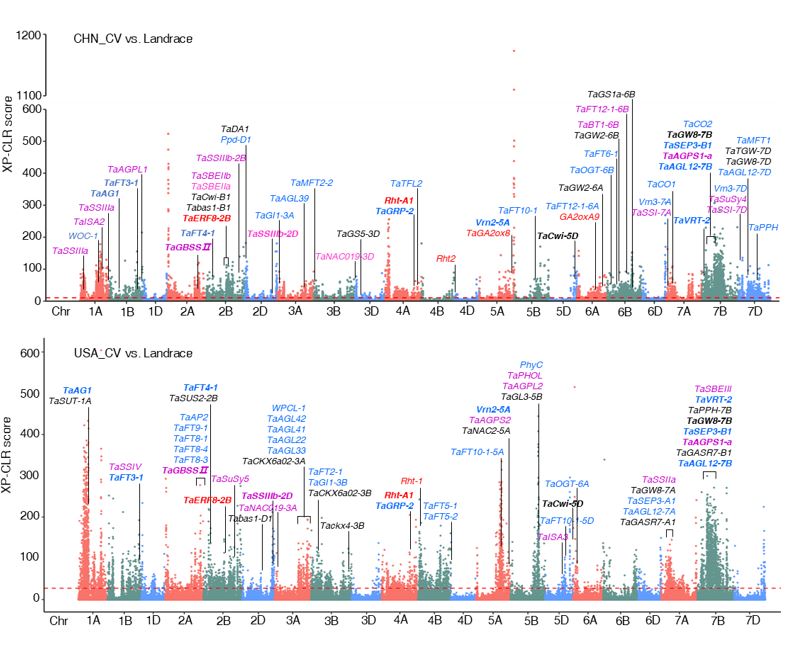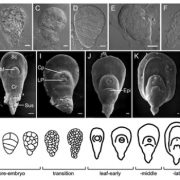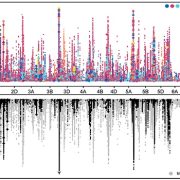Phenotypic and genomic changes during modern wheat breeding in China and the United States
Jianqing Niu et al. explore how modern breeding reshaped wheat phenotype and genome in China and the United States, which will facilitate breeding higher performance wheat in the future.
https://doi.org/10.1093/plcell/koad229
By Jianqing Niu and Hong-Qing Ling from Hainan Yazhou Bay Seed Laboratory and Institute of Genetics and Developmental Biology, Chinese Academy of Sciences.
Background: A landrace is a traditional plant variety capable of tolerating local biotic and abiotic stresses and maintaining intermediate yield levels in low-input farming systems. The development of cultivars from landraces was achieved by human-mediated selection aimed at higher yield, better quality, and stronger fitness. The transition from landraces to elite cultivars is regarded as crop improvement, during which beneficial alleles might gradually accumulate in cultivars. Therefore, understanding the genetic architecture of wheat improvement during the transition from landraces to cultivars in distinct geographic regions will be crucial for developing high-performance varieties in the future.
Question: How has modern wheat breeding reshaped the phenotypic and genomic architecture of wheat in China and the United States?
Findings: We performed a comprehensive comparative analysis (at the phenotypic and genomic levels) of a whole-genome resequencing panel of 355 common wheat accessions representing diverse landraces and modern cultivars from China and the United States. Compared with landraces, the genetic diversity, and phenotypes of modern wheat cultivars from China and the United States changed significantly. Furthermore, we identified breeding targets during modern wheat breeding and determined that breeding for increased productivity in these two geographic regions was accomplished by pyramiding both shared and region-specific variants.
 Next steps: The unique loci selected either in China or the United States can be used to develop high-performance wheat varieties in the future.
Next steps: The unique loci selected either in China or the United States can be used to develop high-performance wheat varieties in the future.
Reference:
Jianqing Niu, Shengwei Ma, Shusong Zheng, Chi Zhang, et al. (2023). Whole-genome sequencing of diverse wheat accessions uncovers genetic changes during modern breeding in China and the United States. https://doi.org/10.1093/plcell/koad229
题目:现代育种对小麦表型和基因组的重塑
背景:约8000多年前,小麦起源于新月沃地,然后逐渐向世界各地传播。在传播过程中形成地方品种,它们能够适应当地环境和胁迫,且在相对较低的投入下保持中等产量。近代小麦育种是对地方品种进行改良,使其成为高产、优质和适应性更强的品种。此过程可能对小麦的表型以及基因组进行极大的重塑。在不同的小麦生产区,可能由于当地气候以及育种者的喜好差异,会培育出截然不同的品种。因此,比较分析现代育种对不同地域的小麦表型和基因组的重塑,可以为培育更加优良的小麦新品种提供重要线索。
问题:现代育种如何重塑中美两国小麦的表型和基因组?
发现:通过对355份来自中国和美国的品种以及其它地区的地方品种进行表型评价和重测序分析发现,与地方品种相比,现代品种表型和遗传多态性均发生了很大的改变,且优异等位基因逐渐积累。此外,还对中美两国的育种靶标进行了分析,鉴定出了中美共有以及独有的育种靶标。
展望未来:他山之石,可以攻玉。将本文鉴定到的优良育种靶标导入到栽培品种,可进一步改良现有品种,增强环境胁迫的适应性,提高产量和品质。









